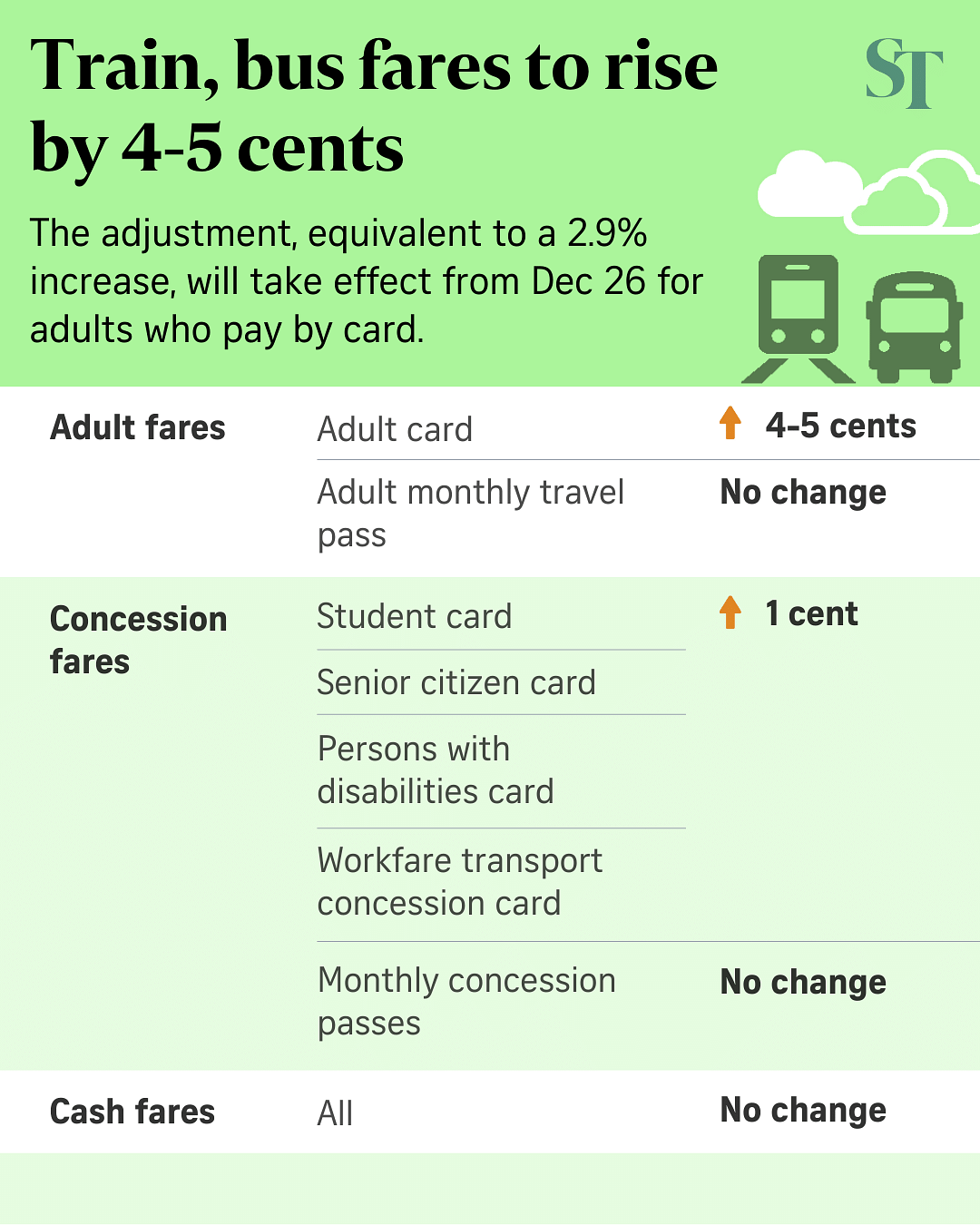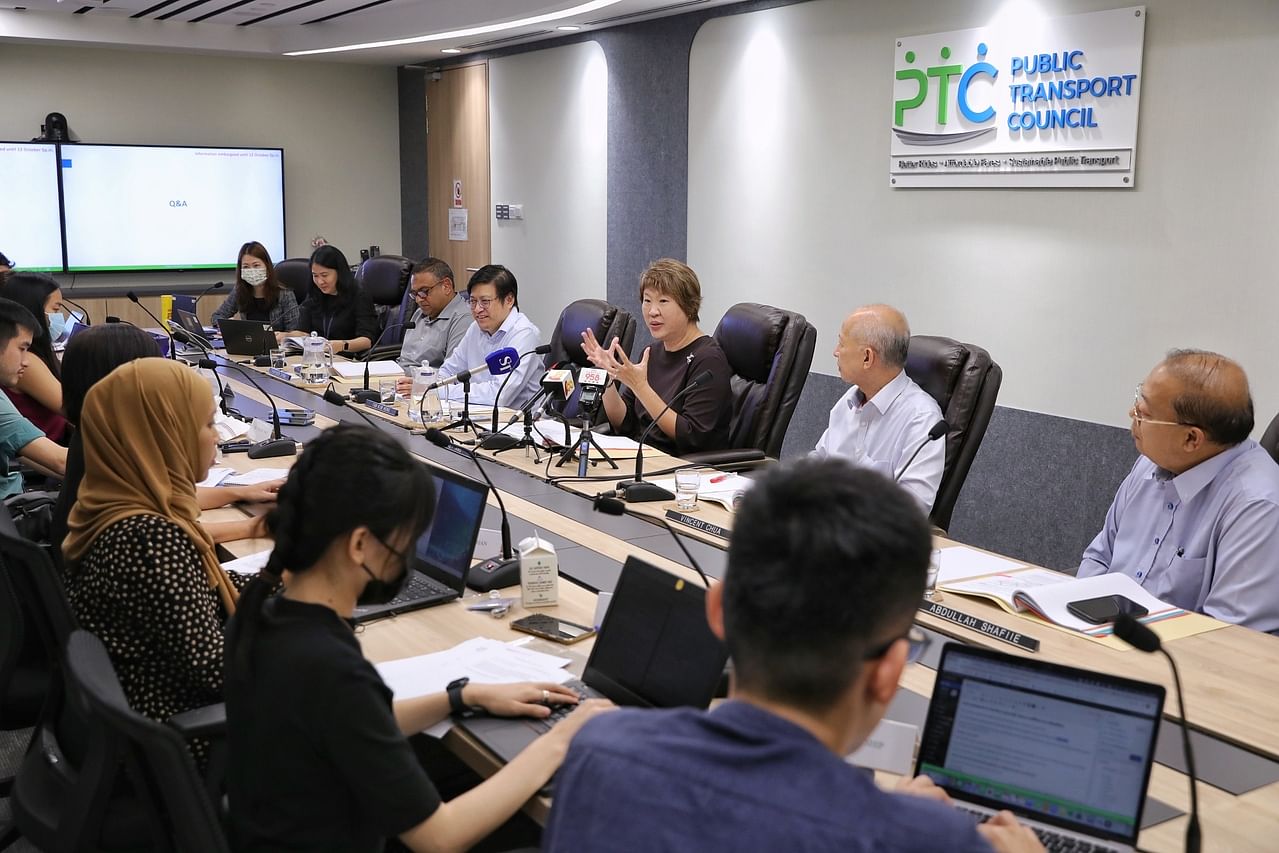Train, bus fares to rise by 4 to 5 cents for adults from Dec 26
Public transport fares will rise for the second year running, going up by 2.9 per cent, with bus and train rides costing four to five cents more from Dec 26 for adults who pay by card.
Concessionary fares for seniors, students, people with disabilities and low-wage workers will go up by one cent per trip, said the Public Transport Council (PTC) Wednesday following its annual fare review exercise. There are about two million commuters in this group, or half of Singaporeans.
Cash fares and the fees for monthly passes will remain unchanged.
From Dec 26, adult commuters paying by card will spend four cents more for journeys of up to 8.2km, and five cents more for journeys longer than 8.2km.
About 54 per cent of public transport journeys taken by adults are below 8.2km.
With the latest hike, a trip between the Boon Lay and Clementi stations on the East-West Line, which is 8.2km in distance, will cost $1.45 for adult commuters using travel cards, up from $1.41 currently.
An 11.5km MRT trip from Harbourfront to Paya Lebar will cost $1.64, up from $1.59.
The PTC said the fare hike could have been much higher.
Citing a significant rise in costs from 2020 to 2021 fuelled by soaring fuel prices, the PTC said the current fare formula would have actually allowed for a maximum fare increase of 13.5 per cent.
A major contributor to this was the increase in energy costs, which rose by 117 per cent in 2021 due to the global energy crunch, the PTC said.
Transport operators SMRT Trains and SBS Transit had both applied for the full 13.5 per cent fare increase this year, citing energy costs, global inflation and challenges in hiring and retaining talent while maintaining high levels of service and reliability.
PTC said it was able to limit the fare increase to 2.9 per cent because the Government is forking out an additional $200 million in public transport subsidies in 2023, on top of the more than $2 billion in subsidies it already pumps in annually.
The remaining increase of 10.6 per cent will be rolled over to future fare reviews.

At a press conference, PTC chairman Janet Ang, who took over the role in May, said fares had to increase due to the spike in energy prices and other costs, such as salary increases for public transport workers.
Ms Ang, who is also a Nominated MP, said the council landed on the 2.9 per cent figure as it was close to the current inflation rate, and a little lower than expected wage increases.
Singapore's core inflation hit a 14-year high of 5.1 per cent in August.
The 2.9 per cent hike keeps public transport affordable for now, she added.
Ms Ang said PTC focused on ensuring there would be a minimal increase in fares for the needy and vulnerable. For instance, the cost of monthly passes for those travelling longer distances stayed the same.
Ms Ang said: "The PTC recognises commuters' concerns over increasing costs of living and the impact of rising inflation in Singapore... We are grateful that the Government has stepped in to support this decision."

The PTC said its indicators show public transport here remains affordable, with households in the 21st to 40th percentile, which represent the average commuter, spending 1.8 per cent of their income on buses and train rides, compared with 2.3 per cent in 2012.
Lower-income households in the 11th to 20th percentile spend about 2.5 per cent of their income on public transport, down from 3.5 per cent ten years ago.
The PTC said that even with the 2.9 per cent fare increase this year, the average monthly public transport expenditure for these households will likely remain the same as last year, given that wages have increased by a greater degree.
To further defray the costs, the Government will give out 600,000 public transport vouchers worth $30 each, as it did in 2021, when fares rose by 2.2 per cent, or three to four cents for adults.
SMRT and SBS Transit will contribute a total of $3.44 million towards this.
The maximum allowable fare increase of 13.5 per cent this year was calculated after the network capacity factor (NCF) was excluded from the fare formula, which also accounts for core inflation, wage increases and productivity.
Introduced in 2018, the NCF tracks how much bus and rail capacity has changed in relation to actual usage, but the PTC said it is not designed to track short-term fluctuations in demand and supply.
The inclusion of the NCF in the fare formula would have skewed the maximum allowable increase even more as public transport ridership in 2021 was still being impacted by Covid-19.
In 2021, 5.3 million daily trips were made by buses and trains. This is 68 per cent of the record high of 7.7 million posted in 2019 before the pandemic.
The PTC is currently in the midst of reviewing the fare formula to account for changes in commuting patterns, and to balance fare affordability and financial sustainability of the public transport sector.
It aims to complete the review process by the first half of 2023.
Get The New Paper on your phone with the free TNP app. Download from the Apple App Store or Google Play Store now


